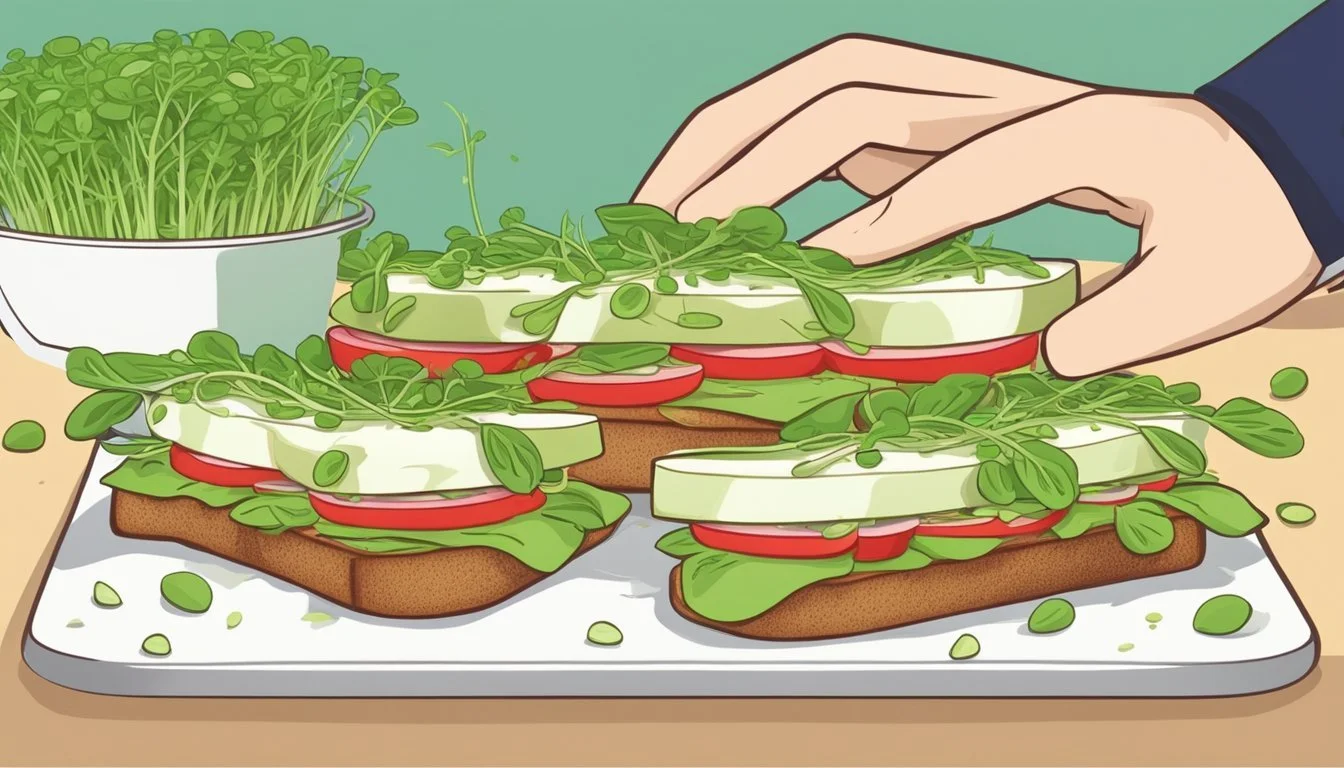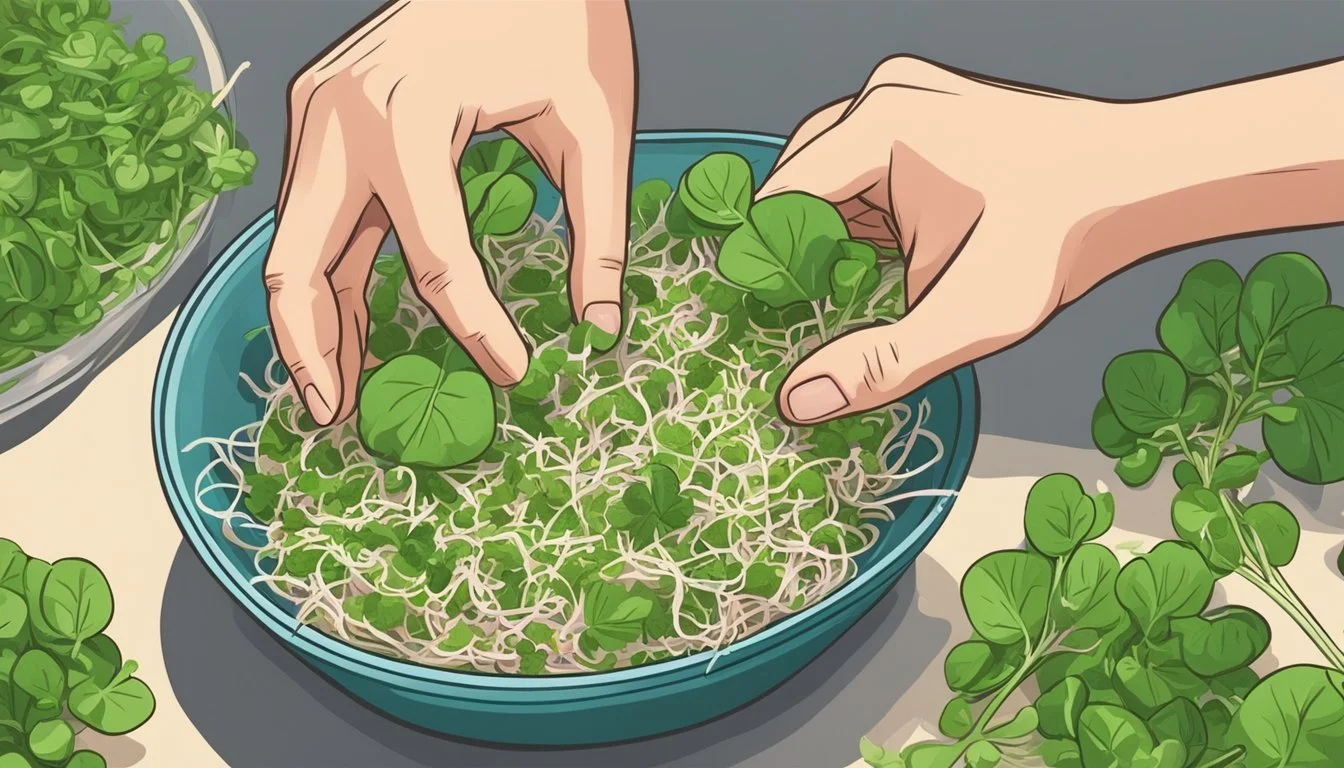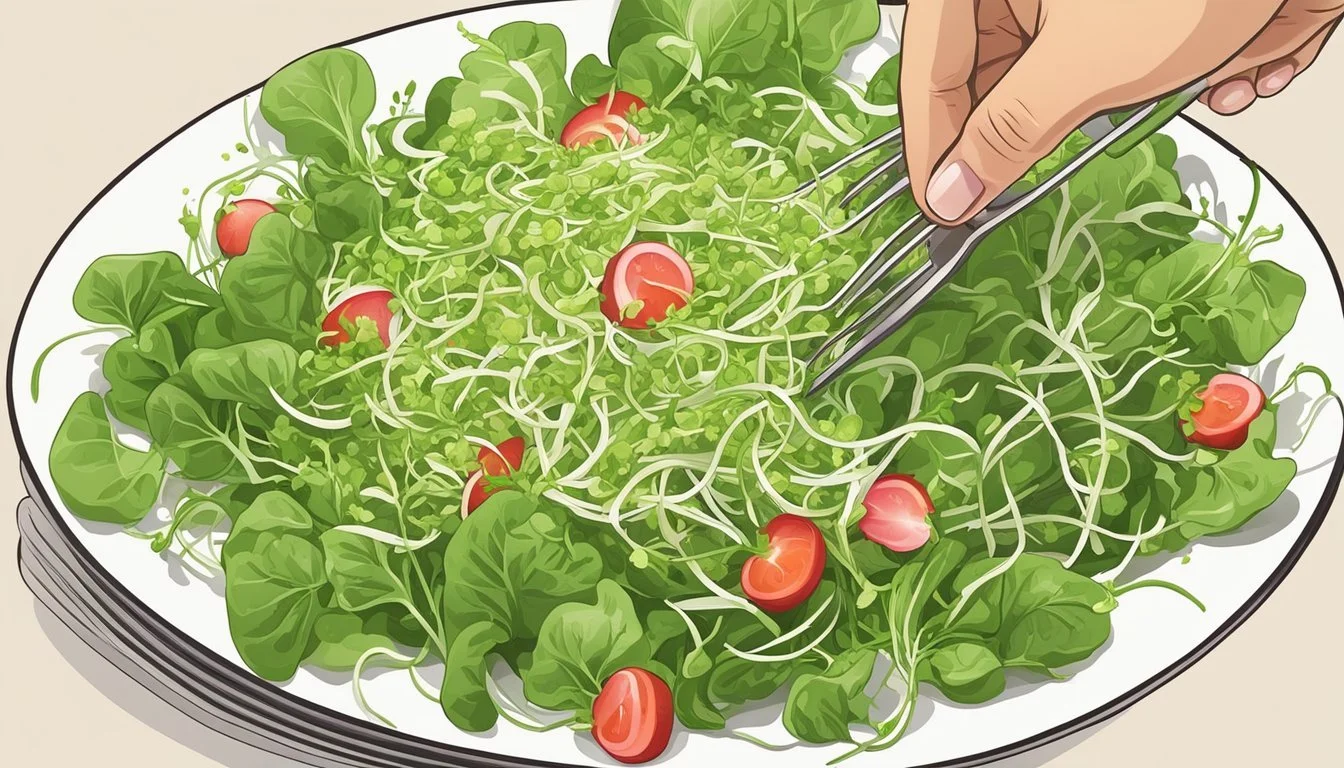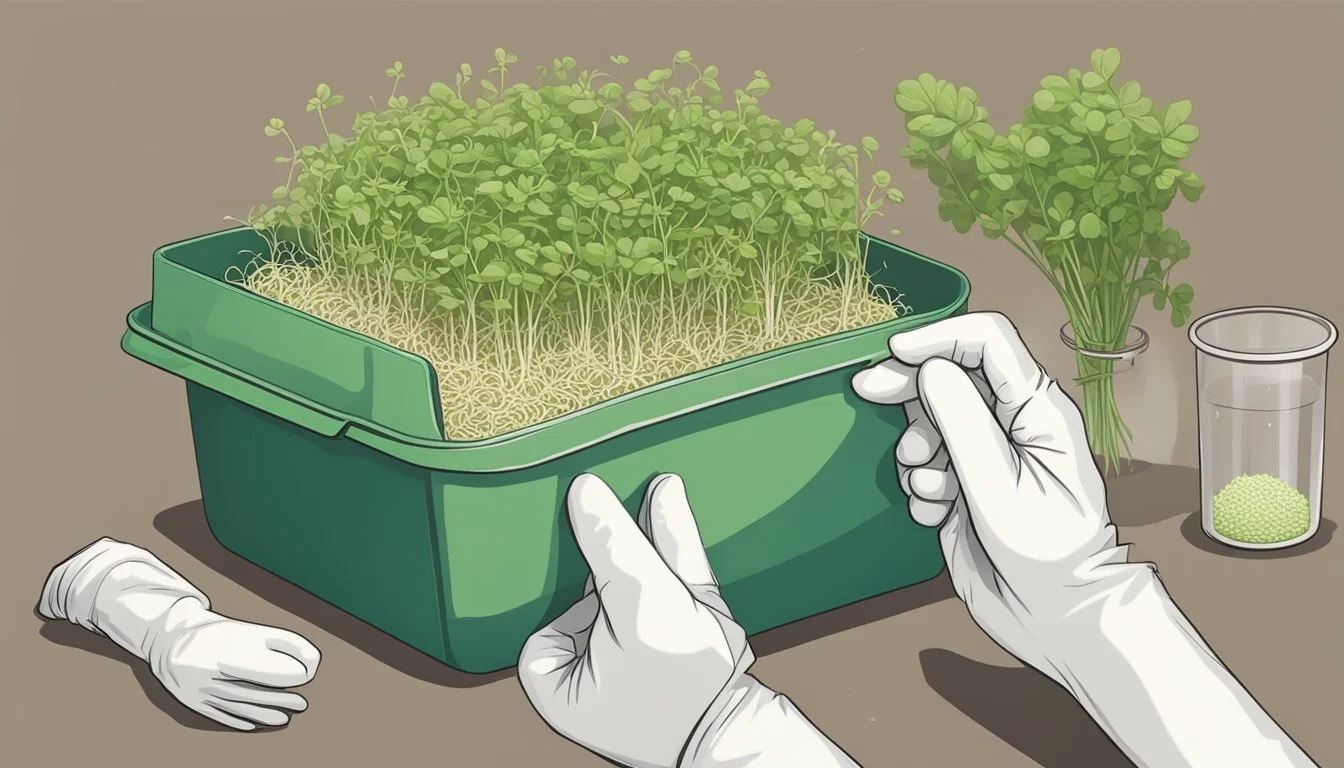How to Substitute Radish Sprouts for Alfalfa Sprouts
A Simple Swap Guide
Radish sprouts offer a peppery alternative to the mild, earthy flavor of alfalfa sprouts and can be used in a variety of culinary applications. They come from the germinated seeds of radishes and possess a distinct, zesty taste that can complement dishes which typically include alfalfa sprouts. In addition to their flavor, radish sprouts have a crunchy texture that remains intact in salads (What wine goes well with salads?) , sandwiches (What wine goes well with sandwiches?), and as garnishes, much like their alfalfa counterparts.
When substituting radish sprouts for alfalfa sprouts, it's important to consider the intensity of flavor they bring to a dish. While alfalfa sprouts are known for their subtle taste, radish sprouts can impart a bold and slightly spicy note. This makes them fitting for those looking to add a bit of kick to their meals. Moreover, the nutritional profiles of radish sprouts are quite beneficial, offering vitamins and minerals alongside plant compounds that contribute to a healthy diet.
Cooks looking for substitutes for alfalfa sprouts will find that radish sprouts are not only readily available but also versatile in their use. They can be used in similar quantities as alfalfa sprouts and require no special preparation modifications. Whether incorporated into a fresh wrap, tossed into a salad, or layered onto a burger, radish sprouts provide an exciting twist while maintaining the fresh, crisp bite that makes sprouts a popular ingredient in numerous dishes.
Understanding Sprouts
Sprouts are nutritious microgreens grown from the germination of seeds into immature shoots. They are a powerhouse of essential nutrients and provide notable health benefits when included in a diet.
Types of Sprouts
Sprouts come from a variety of plant seeds. The most common types include:
Alfalfa Sprouts: Known for their delicate, crisp texture and are commonly added raw to sandwiches and salads.
Bean Sprouts: Such as mung bean sprouts and soybean sprouts, are staples in Asian cuisine and treasured for their crunchy texture.
Broccoli Sprouts: Contain high levels of antioxidants and are often consumed for their potential health properties.
Pea Sprouts: Offer a slightly sweeter taste and are great in salads and stir-fries.
Sunflower Sprouts: Have a nutty flavor and are often used as a garnish or in salads.
Enoki: These are a type of mushroom sprouts, commonly used in Asian dishes.
Nutritional Value of Sprouts
Sprouts are low in calories but rich in :
Vitamins: Such as Vitamin C, Vitamin K, and folate.
Minerals: Like calcium, iron, magnesium, and potassium.
Fiber: Essential for digestive health.
Protein: Important for muscle repair and growth.
The exact nutritional content can vary based on the type of sprout.
Health Benefits of Sprouts
Consuming sprouts may offer several health benefits:
Heart Health: They are known to improve heart health due to their high content of antioxidants.
Immune System: The vitamin C and antioxidants can boost the immune system.
Blood Pressure: Minerals like potassium help in managing blood pressure.
Inflammation: Sprouts can help reduce inflammation, which is beneficial for overall health.
Including sprouts in one's diet supports a healthy lifestyle with their numerous nutrients and health-promoting properties.
Culinary Uses
When substituting radish sprouts for alfalfa sprouts in recipes, one should consider the more robust and peppery flavor of radish sprouts. They can add a bold taste to a variety of dishes while offering a similar texture to alfalfa sprouts.
Using Sprouts in Salads
Radish sprouts can be a flavorful addition to salads. For texture and an extra peppery kick, they can be combined with ingredients like:
Leafy Greens: romaine, spinach, arugula
Vegetables: cherry tomatoes, shredded carrots, bell peppers, cucumber
Crunch: snap peas, shredded cabbage, water chestnuts
Herbs: parsley, cilantro, green onion
One can toss these ingredients together and dress them lightly with vinaigrette to balance the intensity of the radish sprouts.
Incorporating Sprouts in Sandwiches
Radish sprouts can provide an excellent crunchy texture and spicy bite in sandwiches. They pair well with:
Proteins: turkey, chicken, tofu, egg salad
Cheeses: cream cheese, cheddar, provolone
Spreads: hummus, mustard, mayonnaise
Bread: whole grain, sourdough, rye
Layer the radish sprouts with the other sandwich components for a nutritious and satisfying meal.
Sprouts in Asian Cuisine
Radish sprouts can enhance many Asian dishes with their bold flavor, especially in:
Stir-fries: along with bok choy, carrots, bamboo shoots, and bell peppers
Spring Rolls: combined with vermicelli noodles, shrimp, and napa cabbage
Sushi: as a fresh, spicy component inside or on top of rolls
Pad Thai: mixed in with noodles, egg, bean sprouts, and tamarind sauce
Add radish sprouts at the end of cooking to maintain their crisp texture and pungency.
Cooking with Sprouts in Soups
The sharp flavor of radish sprouts can enliven soups, particularly:
Clear Broths: with ingredients like chicken, green onion, and celery
Hearty Soups: integrating cabbage, Chinese cabbage, and snap peas
Noodle Soups: featuring ramen or rice noodles with tofu or shrimp
To preserve their texture and flavor, it is advisable to add radish sprouts as a garnish just before serving.
Sprout Substitutions
When looking to substitute sprouts in a recipe, consideration must be given to how closely the substitute matches the original in texture and taste, ensuring a seamless transition in the dish.
Substituting Radish Sprouts for Alfalfa
Radish sprouts are an excellent replacement for alfalfa sprouts. They share a crunchy texture and are available at most health food stores. When using radish sprouts in place of alfalfa, it's important to note the mildly spicy flavor they bring, which can enhance the overall taste profile of the dish.
Alternative Sprout Options
For those unable to find radish sprouts, there are several other options that can fill in for alfalfa sprouts:
Mung Bean Sprouts: They offer a crunchy texture and a flavor that is mild enough to not overpower other ingredients.
Soybean Sprouts: Known for their nutritious value, they have a slightly bitter taste but maintain the desired crispness.
Sunflower Seed Sprouts: These have a firm texture and a nutty flavor, adding a distinct taste to salads and sandwiches.
Pea Sprouts: With their sweet and mild taste, pea sprouts can add a pleasant flavor variance in dishes.
Enoki Mushrooms: While not a sprout, enoki mushrooms provide a crunch similar to sprouts and can be used as a substitute in cooked dishes.
Considering Texture and Flavor
When substituting any sprout for another, the two aspects to closely match are texture and flavor. Alfalfa sprouts are known for their crunchy texture and mild taste, making them a versatile ingredient in many dishes. The selected substitute should similarly complement other flavors without dominating them.
Health and Safety
When substituting radish sprouts for alfalfa sprouts, one must consider both the health benefits and the safety risks associated with raw sprouts. The following subsections detail the potential risks and the best practices for handling sprouts to ensure one's health.
Risks Associated with Raw Sprouts
Raw sprouts, including radish and alfalfa sprouts, carry a risk of containing foodborne pathogens such as Listeria, Salmonella, and E. coli. These organisms can lead to severe illnesses, especially in those with weakened immune systems. Despite the health benefits that sprouts offer, such as being rich in vitamins and low in calories, safety is a paramount concern.
Listeria: Can cause listeriosis, characterized by fever and muscle aches, and may be more severe for pregnant women and their newborns.
Salmonella: Symptoms include diarrhea, fever, and abdominal cramps, typically appearing 6 hours to 6 days after infection.
Sprouts' warm and humid growing conditions favor the growth of these pathogens, making raw consumption a health concern.
Best Practices for Handling Sprouts
To minimize health risks, certain safety measures are recommended when handling sprouts:
Washing: Vigorously wash sprouts under running water to remove surface dirt and potential contaminants.
Refrigeration: Store sprouts at 40°F (4°C) or below to slow down the growth of harmful bacteria.
Cooking: Cooking sprouts until they are steaming hot can kill most bacteria, making them safer to eat.
Those particularly at risk, such as pregnant women, the elderly, young children, and individuals with compromised immune systems, might consider avoiding raw sprouts altogether for better health.
Growing and Harvesting Your Own Sprouts
Growing radish sprouts at home is an accessible way to substitute for alfalfa, providing a nutritious and tasty addition to many dishes. Harvesting and storing these sprouts involves simple steps that ensure their freshness and flavor.
Sprouting Seeds at Home
To grow radish sprouts, one begins by selecting high-quality radish seeds. The seeds should be placed in a jar, covered with water, and left to soak overnight. Following the initial soak, the seeds will need to be drained and rinsed with fresh water every 8-12 hours. For optimal growth, the ideal temperature range is between 65°F to 75°F. The sprouts should be kept in a well-ventilated spot that is out of direct sunlight to prevent overheating, which could impede the sprouting process.
Steps for Sprouting Radish Seeds:
Soak radish seeds in a jar filled with water for 6-12 hours.
Drain the water and rinse the seeds thoroughly.
Store the jar in a cool, ventilated area, avoiding direct sunlight.
Rinse and drain the seeds every 8-12 hours.
Watch for sprouts to appear, typically within 3 to 5 days.
Harvesting and Storing Homegrown Sprouts
When radish sprouts have reached a desirable size, usually around 3 to 5 days, they are ready for harvesting. The sprouts should be rinsed thoroughly to remove any seed hulls and roots that may have come loose. For storage, ensure the radish sprouts are dried to prevent mold and spoilage.
Harvesting Steps:
Rinse the radish sprouts to clean and remove loose hulls.
Drain them well and gently pat dry with a paper towel.
Refrigerate the sprouts in an airtight container.
For the best quality and flavor, consume the homegrown radish sprouts within a week. They make an excellent substitute for alfalfa sprouts in salads, sandwiches, and wraps, offering a peppery kick that alfalfa does not provide. Additionally, unlike alfalfa, radish sprouts can be briefly heated in dishes like stir-fries, provided they are added at the very end of the cooking process.
Shopping for Sprouts
When substituting radish sprouts for alfalfa sprouts, consumers should focus on locating a variety of sprouts and discerning their quality to ensure they obtain the best nutritional value and appearance for their dishes.
Where to Find Sprouts
Sprouts, including radish and its alternatives such as legumes and mustard greens, can typically be found in the produce section of supermarkets. Specialty health food stores and farmers' markets are also excellent sources for a wider variety of sprouts. For those wanting to explore beyond traditional stores, green onions can serve as a flavorful garnish and are widely available in most grocery outlets.
Supermarkets: Check the produce aisle near salad greens.
Health Food Stores: Look for organic and non-GMO options.
Farmers' Markets: Offers locally-grown, fresh sprouts.
Selecting Quality Sprouts
The selection of high-quality sprouts hinges on assessing their freshness and appearance. Radish sprouts should look vibrant and crisp, without any signs of wilting or discoloration. Both radish and alfalfa sprouts should be free from any unpleasant odors, a sign of freshness and good nutritional value. When inspecting legumes and mustard greens, ensure they have a bright appearance and a firm texture, indicating they are suitable for consumption.
Appearance:
Radish Sprouts: Vibrant, crisp, and uniformly green.
Alfalfa Sprouts: Light green and fresh-looking.
Legumes/Mustard Greens: Bright color and firm to the touch.
Freshness:
Odor: There should be no unpleasant smells.
Texture: Sprouts should be moist but not soggy.
Conclusion
Radish sprouts serve as an excellent substitute for alfalfa sprouts, allowing culinary enthusiasts to make knowledgeable choices in their dishes. They possess a bolder flavor compared to the mild taste of alfalfa sprouts, adding a peppery kick to salads, sandwiches, and wraps. These sprouts bring not only a dynamic flavor profile but also an attractive red-tinged aesthetic that can enhance the visual appeal of meals.
When replacing alfalfa sprouts with radish sprouts, chefs should consider the following:
Flavor Profile: Adjust seasonings to complement the spicier radish sprouts.
Texture: Radish sprouts have a similar crunch, making them a suitable textural match.
Nutritional Value: They are a great source of vitamins and minerals, much like alfalfa sprouts.
Here is a quick-reference table for substituting radish sprouts:
Alfalfa Sprouts Radish Sprouts Consideration Mild flavor Spicier flavor Adjust other spices and flavorings Soft texture Similar texture No adjustment needed
Chefs can confidently use radish sprouts as a substitute, knowing they will bring a distinctive flavor and a nutritious boost to their recipes. It is important that the substitution is done with mindfulness of the taste preferences of the diners, ensuring the dish remains enjoyable for everyone.







